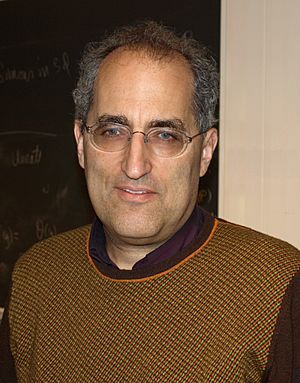M-theory facts for kids
M-theory is a big idea in physics. It tries to explain how the universe works at its smallest level. It's part of something called superstring theory. Edward Witten first suggested M-theory. Scientists often debate it because it's hard to test. If proven true, M-theory could greatly advance science.
Contents
Understanding String Theory
To understand M-theory, it helps to know about string theory first. For a long time, scientists thought the smallest things in the universe were like tiny dots or points. String theory says this is wrong. It suggests that the simplest things are actually shaped like tiny pieces of string.
These strings are incredibly small. Even if you look very closely, they still appear like points. String theory says that every basic particle, like an electron, is made when these strings vibrate in different ways. Imagine a guitar string: different vibrations make different musical notes. In string theory, different vibrations make different particles.
Why String Theory is Important
String theory was developed to solve a big problem in physics. For almost 100 years, two major theories have not agreed. Albert Einstein's theory of general relativity describes how the universe works on very large scales, like planets and galaxies. But it doesn't get along with two theories that describe things on very small scales. These are quantum mechanics and the Standard Model.
The Standard Model also has its own problems:
- It uses about 20 numbers that scientists can't explain.
- It has too many "basic particles." Some scientists think there should be fewer.
- It doesn't include gravity. Gravity is needed to explain things like weight.
How Strings Help Solve Problems
Thinking of basic particles as strings can solve many of these issues. Now, there is only one number that needs explaining. This number tells us the size of the strings. String theory also includes particles that cause gravity. These are called gravitons. Finding this out made string theorists very happy. So, string theory successfully brings General Relativity and Quantum Mechanics together.
The Challenge of Dimensions
But string theory has some challenges. Normally, we think the universe has 4 dimensions. These are like basic directions. Three directions are "up/down," "forward/backward," and "left/right." The fourth direction is time. String theory, however, needs 10 basic directions.
These six extra directions can be explained if they are "curled up." This means they are much too small for us to see. Imagine walking along a spiral staircase. You can go a long way around the spiral without moving far up or down. The 6 extra directions are like tiny spirals. Strings can move along them a great distance but not seem to move far in our normal view. This is a clever mathematical idea that helps the theory work.
Many Versions of String Theory
Another problem with string theory is that there are 5 different versions of it. Each version allows different kinds of strings. They also say strings work in different ways. String theory is supposed to be a "theory of everything." So, there should be only one version, not five. M-theory helps solve this problem.
Introducing M-theory

In 1995, Edward Witten started what is called the Second Superstring Revolution. He did this by introducing M-theory to the world. This new theory combines the 5 different string theories. It also includes an older idea called 11D-Supergravity. This older idea was an attempt to combine General Relativity and Quantum Mechanics.
Witten suggested that all these different theories were connected. He believed they were all just different ways of looking at one deeper, underlying theory. This main theory, M-theory, is still a bit vague. Scientists are still working to fully understand it.
More Dimensions!
It was also found that the math for string theory, which needed 10 dimensions, was not quite complete. The proposed M-theory would need one extra dimension. This means it would be a theory that takes place in 11 dimensions. Witten himself compared this idea to a general on a hilltop. The extra space-coordinate (the hilltop) gives a better view of the battlefield's two other dimensions.
Connecting the Theories with Dualities
M-theory connects all the different string theories using something called "dualities." These are like special relationships between the theories. The main dualities are S-duality, T-duality, and U-duality. Each duality shows how one string theory can be changed into another.
T-duality is one of the easier dualities to explain. It has to do with the size of the "curled up" dimensions. Scientists found that if you take a Type IIA string theory with a certain size (let's call it R) and change that size to 1/R, you get something that acts like a Type IIB theory of size R. This and other dualities show how all 5 (or 6, if you count supergravity) theories are linked. Scientists knew about these dualities before Witten came up with M-theory.
Many people have fun guessing what the "M" in M-theory stands for. Some ideas include Matrix, Magic, Muffin, Mystery, Mother, and Membrane. No matter what the M means, M-theory is one of the most exciting and active areas of research in physics today.
See also
 In Spanish: Teoría M para niños
In Spanish: Teoría M para niños

